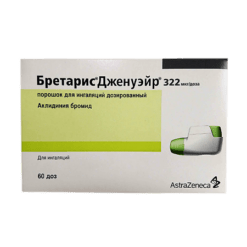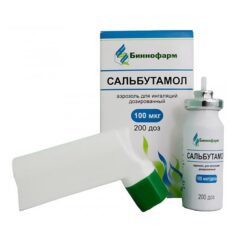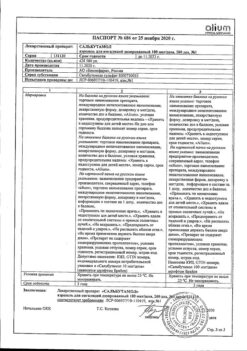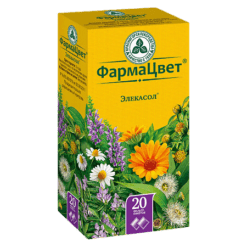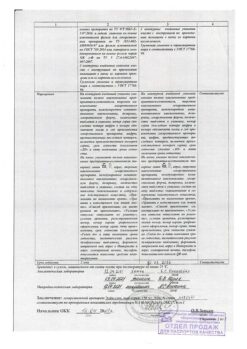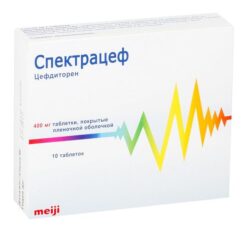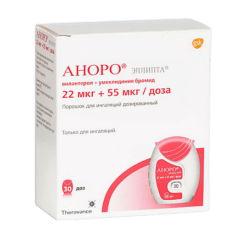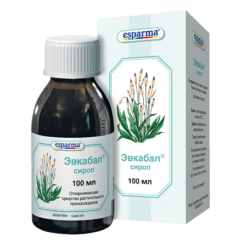No products in the cart.
Astmasol Neo, aerosol 20 mcg/dose+50 mcg/dose 200 doses
€13.19 €10.99
Description
Bronchodilator combined (m-cholinoblocker + ß2-adrenomimetic selective) ATX code: R03AL01 Pharmacological properties
Pharmacodynamics
The drug contains two components with bronchodilator activity: ipratropium bromide – m-cholinoblocker and fenoterol – ß2-adrenomimetic.
The bronchodilation by inhaled administration of ipratropium bromide is mainly due to local rather than systemic anticholinergic action.
Ipratropium bromide is a quaternary ammonium derivative with anticholinergic (parasympatholytic) properties. Ipratropium bromide inhibits vagus nerve reflexes. Anticholinergic agents prevent an increase in intracellular calcium ion concentration, which occurs due to the interaction of acetylcholine with muscarinic receptors of bronchial smooth muscles. The release of calcium ions is mediated by a system of secondary mediators, which include inositol triphosphate (ITP) and diacylglycerol (DAG).
In patients with bronchospasm associated with chronic obstructive pulmonary disease (chronic bronchitis and pulmonary emphysema), a significant improvement in lung function (increase in forced expiratory volume in 1 second (OOB1) and peak expiratory flow (PEF) by 15% or more) is observed within 15 minutes, the maximum effect is achieved after 1-2 hours and continues in most patients up to 6 hours after administration.
Ipratropium bromide has no adverse effect on airway mucus secretion, mucociliary clearance and gas exchange.
Phenoterol selectively stimulates ß2-adrenoreceptors at therapeutic dose.
Stimulation of ß2-adrenoceptors occurs at high doses.
Phenoterol relaxes the smooth muscles of the bronchi and blood vessels and counteracts bronchoconstriction reactions caused by histamine, methacholine, cold air and allergens (immediate-type hypersensitivity reactions).
Fenoterol blocks the release of mediators of inflammation and bronchoobstruction from mast cells immediately after administration. In addition, increased mucociliary clearance has been observed with fenoterol doses of 0.6 mg.
The ß-adrenergic (ß-adrenoreceptor stimulating) effects of the drug on cardiac activity, such as increased heart rate and force, are due to the vascular action of fenoterol, stimulation of ß2-adrenoreceptors of the heart, and when using doses greater than therapeutic, stimulation of ß1-adrenoreceptors.
As with other ß-adrenergic drugs, prolongation of the QTC interval is noted with high doses. When fenoterol was used with metered dose aerosol inhalers (MDIs), this effect was inconsistent and was noted when doses higher than recommended were used.
Tremor is the most common undesirable effect when using ß-adrenoreceptor agonists. When these two active agents are used together, the bronchodilator effect is achieved by affecting different pharmacological targets. These substances complement each other, and as a result the antispasmodic effect on the bronchial muscles is increased and a greater breadth of therapeutic action in bronchopulmonary diseases accompanied by airway constriction is provided.
The complementary action is such that a lower dose of the ß-adrenergic component is required to achieve the desired effect, allowing an individualized effective dose with virtually no side effects.
In acute bronchoconstriction, the effect of the drug develops quickly, allowing it to be used in acute attacks of bronchospasm.
Pharmacokinetics
There is no evidence that the pharmacokinetics of the combined product containing ipratropium bromide and phenoterol differ from those of each of the individual components.
Ipratropium bromide absorption
Ipratropium bromide. When administered by inhalation, ipratropium bromide is characterized by extremely low absorption from the respiratory mucosa.
The plasma concentration of ipratropium bromide is at the lower limit of determination, and can only be measured when high doses of the active substance are used. After inhalation the lungs usually receive (depending on the dosage form and inhalation method) 10-30% of the administered dose of ipratropium bromide. Most of the dose is swallowed and enters the gastrointestinal tract.
A portion of the dose of ipratropium bromide that enters the lungs quickly reaches the systemic bloodstream (within minutes). The total systemic bioavailability of ipratropium bromide administered orally and inhaled is 2% and 7-28%, respectively.
Phenoterol.
Depending on the method of inhalation and the inhalation system used, about 10-30% of fenoterol reaches the lower airways, and the rest is deposited in the upper airways and swallowed. As a result, some amount of inhaled fenoterol reaches the gastrointestinal tract.
As absorption is biphasic – 30% of fenoterol is rapidly absorbed with a half-life (T½) of 11 minutes, and 70% is slowly absorbed with a T½ of 120 minutes. There is no correlation between the plasma concentrations of fenoterol achieved after inhalation and the pharmacodynamic “time-effect” curve. Long-term (3-5 hours) bronchodilator effect after inhalation, comparable with the corresponding effect achieved after intravenous administration, is not supported by high concentrations of fenoterol in the systemic bloodstream. After oral administration, about 60% of fenoterol is absorbed. Time of reaching maximum plasma concentration is 2 hours.
Distribution
Ipratropium bromide, which is a quaternary amine, is poorly soluble in fat and poorly penetrates through biological membranes. It does not cumulate. Ipratropium bromide binds to plasma proteins to a minimal extent (less than 20%). There are no data on the possibility of penetration of ipratropium bromide through the placental barrier and into the breast milk.
Phenoterol is intensively distributed to organs and tissues. Binding with blood plasma proteins is 40-55%. Fenoterol passes through the placental barrier unchanged and is excreted with breast milk.
Metabolism
Ipratropium bromide is metabolized by oxidation mainly in the liver. Up to 8 metabolites of ipratropium bromide are known, which bind weakly to muscarinic receptors and are considered inactive.
Phenoterol is metabolized in the liver. After 24 hours, 60% of the intravenous dose and 35% of the oral dose are excreted in the urine. This fraction of fenoterol undergoes biotransformation due to the “primary passage” effect through the liver, causing the bioavailability of the drug to fall to approximately 1.5% after oral administration. This explains the fact that the swallowed amount of the drug has almost no effect on the plasma concentration of the active substance achieved after inhalation. Biotransformation of fenoterol in humans occurs primarily by conjugation with sulfates in the intestinal wall.
Ipratropium bromide is excreted mainly through the intestine and also through the kidneys. About 25% is excreted unchanged, the rest is excreted as metabolites.
Phenoterol is excreted by the kidneys and with bile as inactive sulfate conjugates.
In parenteral administration, phenoterol is excreted according to a three-phase model with half-lives of 0.42 minutes, 14.3 minutes and 3.2 hours.
Pharmacokinetics in selected patient groups
Pharmacokinetics of the combined product containing ipratropium bromide and fenoterol have not been studied in diabetic patients, elderly patients, children, and patients with liver or renal dysfunction.
Indications
Indications
Prevention and symptomatic treatment of obstructive airway diseases with reversible airway obstruction: chronic obstructive pulmonary disease (COPD), bronchial asthma, chronic bronchitis, complicated or uncomplicated by emphysema.
Pharmacological effect
Pharmacological effect
Combined bronchodilator (m-anticholinergic blocker + selective ß2-adrenergic agonist)
ATX code: R03AL01
Pharmacological properties
Pharmacodynamics
The drug contains two components with bronchodilator activity: ipratropium bromide – an m-anticholinergic blocker and fenoterol – a ß2-adrenergic agonist.
Bronchodilation with inhaled ipratropium bromide is due primarily to local rather than systemic anticholinergic effects.
Ipratropium bromide is a quaternary ammonium derivative with anticholinergic (parasympathetic) properties. Ipratropium bromide inhibits reflexes caused by the vagus nerve. Anticholinergics prevent an increase in the intracellular concentration of calcium ions, which occurs due to the interaction of acetylcholine with muscarinic receptors of bronchial smooth muscles. The release of calcium ions is mediated by a system of secondary mediators, which include inositol triphosphate (ITP) and diacylglycerol (DAG).
In patients with bronchospasm associated with chronic obstructive pulmonary diseases (chronic bronchitis and emphysema), a significant improvement in lung function (increase in forced expiratory volume in 1 second (OOB1) and peak expiratory flow (PEF) by 15% or more) is observed within 15 minutes, the maximum effect is achieved after 1-2 hours and lasts in most patients up to 6 hours after administration.
Ipratropium bromide does not have a negative effect on mucus secretion in the respiratory tract, mucociliary clearance and gas exchange.
Fenoterol selectively stimulates ß2-adrenergic receptors in a therapeutic dose.
Stimulation of ß2-adrenergic receptors occurs when high doses are used.
Fenoterol relaxes the smooth muscles of the bronchi and blood vessels and counteracts the development of bronchosiastic reactions caused by the influence of histamine, methacholine, cold air and allergens (immediate hypersensitivity reactions).
Immediately after administration, fenoterol blocks the release of mediators of inflammation and bronchial obstruction from mast cells. In addition, when using fenoterol in doses of 0.6 mg, an increase in mucociliary clearance was observed.
The ß-adrenergic (stimulating ß-adrenergic receptors) effect of the drug on cardiac activity, such as an increase in the frequency and strength of heart contractions, is due to the vascular effect of fenoterol, stimulation of ß2-adrenergic receptors of the heart, and when using doses exceeding therapeutic doses, stimulation of ß1-adrenergic receptors.
As with the use of other ß-adrenergic drugs, a prolongation of the QTC interval is observed when using high doses. When fenoterol was used via metered-dose aerosol inhalers (MDIs), the effect was inconsistent and occurred at doses higher than recommended.
However, after administration of fenoterol via nebulizers (a solution for inhalation in vials or tube droppers with a standard dose), systemic exposure may be higher than when using the drug using a MDI at recommended doses. The clinical significance of these observations has not been established. The most commonly observed effect of ß-adrenergic agonists is tremor. In contrast to the effect on bronchial smooth muscle, tolerance may develop to the systemic effects of ß-adrenergic receptor agonists; the clinical significance of this manifestation is not clear.
Tremor is the most common adverse effect with beta-adrenergic agonists. When these two active substances are used together, the bronchodilator effect is achieved by acting on various pharmacological targets. These substances complement each other, as a result, the antispasmodic effect on the bronchial muscles is enhanced and a greater breadth of therapeutic action is provided for bronchopulmonary diseases accompanied by constriction of the airways.
The complementary effect is such that to achieve the desired effect, a lower dose of the ß-adrenergic component is required, which allows you to individually select an effective dose with virtually no side effects.
In acute bronchoconstriction, the effect of the drug develops quickly, which allows its use in acute attacks of bronchospasm.
Pharmacokinetics
There is no evidence that the pharmacokinetics of a combination product containing ipratropium bromide and fenoterol differs from that of each of the individual components.
Suction
Ipratropium bromide. When administered via inhalation, ipratropium bromide is characterized by extremely low absorption from the mucous membrane of the respiratory tract.
The concentration of ipratropium bromide in blood plasma is at the lower limit of definition, and it can only be measured when using high doses of the active substance. After inhalation, 10-30% of the administered dose of ipratropium bromide usually enters the lungs (depending on the dosage form and method of inhalation). Most of the dose is swallowed and enters the gastrointestinal tract.
The portion of the dose of ipratropium bromide that enters the lungs quickly reaches the systemic circulation (within a few minutes). The total systemic bioavailability of ipratropium bromide administered orally and inhaled is 2% and 7-28%, respectively.
Fenoterol.
Depending on the method of inhalation and the inhalation system used, about 10-30% of fenoterol reaches the lower respiratory tract, and the rest is deposited in the upper respiratory tract and ingested. As a result, some amount of inhaled fenoterol enters the gastrointestinal tract.
Absorption is biphasic – 30% of fenoterol is rapidly absorbed with a half-life (T½) of 11 minutes, and 70% is absorbed slowly with T½ – 120 minutes. There is no correlation between fenoterol plasma concentrations achieved after inhalation and the pharmacodynamic time-effect curve. The long-term (3-5 hours) bronchodilator effect of the drug after inhalation, comparable to the corresponding effect achieved after intravenous administration, is not supported by high concentrations of fenoterol in the systemic circulation. After oral administration, about 60% of fenoterol is absorbed. The time to reach maximum concentration in blood plasma is 2 hours.
Distribution
Ipratropium bromide, a quaternary amine, is poorly soluble in fats and poorly penetrates biological membranes. Does not cumulate. Ipratropium bromide binds to plasma proteins to a minimal extent (less than 20%). There is no data on the possibility of ipratropium bromide passing through the placental barrier and into breast milk.
Fenoterol is intensively distributed throughout organs and tissues. The connection with blood plasma proteins is 40-55%. Fenoterol penetrates unchanged through the placental barrier and is excreted in breast milk.
Metabolism
Ipratropium bromide is metabolized by oxidation primarily in the liver. Up to 8 metabolites of ipratropium bromide are known, which weakly bind to muscarinic receptors and are considered inactive.
Fenoterol is metabolized in the liver. After 24 hours, 60% of the intravenously administered dose and 35% of the oral dose are excreted in the urine. This proportion of fenoterol undergoes biotransformation due to the “first pass” effect through the liver, as a result of which the bioavailability of the drug after oral administration drops to approximately 1.5%. This explains it. that the ingested amount of the drug has virtually no effect on the concentration of the active substance in the blood plasma achieved after inhalation. The biotransformation of fenoterol in humans occurs primarily through conjugation with sulfates in the intestinal wall.
Removal
Ipratropium bromide is excreted primarily through the intestines and also through the kidneys. About 25% is excreted unchanged, the rest in the form of metabolites.
Fenoterol is excreted by the kidneys and bile in the form of inactive sulfate conjugates.
When administered parenterally, fenoterol is excreted according to a three-phase model with half-lives of 0.42 minutes, 14.3 minutes and 3.2 hours.
Pharmacokinetics in selected patient groups
The pharmacokinetics of a combination drug containing ipratropium bromide and fenoterol in patients with diabetes mellitus, elderly and older patients, children, as well as in patients with impaired liver and kidney function.
Special instructions
Special instructions
Dyspnea
If shortness of breath (difficulty breathing) suddenly increases rapidly, you should consult a doctor immediately.
Children
In children, Astmasol® neo should be used only as prescribed by a doctor and under the supervision of adults.
Use in children under 6 years of age is contraindicated due to lack of experience with use.
Hypersensitivity
After using the drug Astmasol® neo, immediate hypersensitivity reactions may occur, signs of which in rare cases may include: urticaria, angioedema, rash, bronchospasm, oropharyngeal edema, anaphylactic shock.
Paradoxical bronchospasm
The drug Astmasol® neo, like other inhaled drugs, can cause paradoxical bronchospasm, which can be life-threatening. In case of paradoxical bronchospasm, the use of the drug Astmasol® neo should be stopped immediately and switched to alternative therapy.
Long-term use
In patients with bronchial asthma, the drug should be used only as needed. In patients with mild COPD, symptomatic treatment may be preferable to regular use.
Patients suffering from bronchial asthma should remember the need to carry out or enhance anti-inflammatory therapy to control the inflammatory process of the respiratory tract and the course of the disease.
Regular use of increasing doses of drugs containing ß2-adrenergic agonists, such as the drug Astmasol® neo, to relieve bronchial obstruction can cause uncontrolled worsening of the disease. In case of increased bronchial obstruction, increase the dose of ß2-adrenergic agonists. including the drug Astmasol® neo, more than recommended for a long time is not only not justified, but also dangerous. To prevent life-threatening worsening of the disease, a review of the patient’s treatment plan and adequate anti-inflammatory therapy with inhaled glucocorticosteroids should be considered.
Other sympathomimetic bronchodilators should be prescribed simultaneously with Astmasol® neo only under medical supervision.
Gastrointestinal disorders
In patients with a history of cystic fibrosis, gastrointestinal motility disorders are possible.
Visual disorders
The drug Astmasol® neo should be used with caution in patients predisposed to angle-closure glaucoma. There are isolated reports of complications from the organ of vision (for example, increased intraocular pressure, mydriasis, angle-closure glaucoma, eye pain) that developed when inhaled ipratropium bromide (or ipratropium bromide in combination with ß2-adrenergic agonists) entered the eyes.
Symptoms of acute angle-closure glaucoma may include pain or discomfort in the eyes, blurred vision, the appearance of a halo around objects and colored spots in front of the eyes, combined with swelling of the cornea and redness of the eyes due to conjunctival hyperemia. If any combination of these symptoms develops, the use of eye drops that reduce intraocular pressure and immediate consultation with a specialist is indicated.
Patients should be instructed on the correct use of the inhaled drug Astmasol® neo. Patients predisposed to developing glaucoma should take special care to protect their eyes.
Systemic effects
In diseases such as recent myocardial infarction, diabetes mellitus with inadequate glycemic control, severe organic heart and vascular diseases, hyperthyroidism, pheochromocytoma or urinary tract obstruction (for example, prostatic hyperplasia or bladder neck obstruction), Astmasol® neo should be used only after a careful risk/benefit assessment, especially when using doses exceeding the recommended ones.
Effect on the cardiovascular system
There have been rare cases of myocardial ischemia when taking ß2-agonists. Patients with concomitant serious heart disease (for example, coronary heart disease, arrhythmias or severe heart failure) receiving Astmasol® neo should be warned to consult a doctor if they experience heart pain or other symptoms indicating worsening of heart disease. It is necessary to pay attention to symptoms such as shortness of breath and chest pain, as they can be of both cardiac and pulmonary etiology.
Hypokalemia
When using ß2-agonists, hypokalemia may occur (see section “Overdose”).
In athletes, the use of the drug Astmasol® neo due to the presence of fenoterol in its composition can lead to positive results of doping tests. Please note that the drug contains a small amount of ethanol (13.313 mg per dose).
Impact on the ability to drive vehicles and machinery
No studies have been conducted to study the effect of the drug on the ability to drive vehicles and machines.
Caution should be exercised when performing these activities, as dizziness, tremor, impaired eye accommodation, mydriasis and blurred vision may develop. If the above undesirable sensations occur, you should refrain from such potentially dangerous actions as driving vehicles and machinery.
Active ingredient
Active ingredient
Ipratropium bromide, Fenoterol
Composition
Composition
For 1 dose
Active ingredients:
Ipratropium bromide monohydrate 0.021 mg, equivalent to ipratropium bromide 0.020 mg
Fenoterol hydrobromide 0.050 mg
Excipients:
Anhydrous ethanol (absolute ethyl alcohol) 13.313 mg
Water for injection 0.799 mg
Anhydrous citric acid 0.001 mg
Propellant HFA-134a (1,1,1,2-tetrafluoroethane) 39.070 mg.
Pregnancy
Pregnancy
Pregnancy
Current clinical experience has shown that fenoterol and ipratropium do not have a negative effect on pregnancy. However, normal precautions should be taken when using these drugs during pregnancy, especially during the first trimester. The inhibitory effect of fenoterol on uterine contractility should be taken into account.
Breastfeeding period
Preclinical studies have shown that fenoterol hydrobromide can pass into breast milk. No such data have been obtained for ipratropium. Significant exposure of an infant to ipratropium, especially when administered as an aerosol, is unlikely. However, given the ability of many drugs to pass into breast milk, caution should be exercised when prescribing Astmasol® neo to breastfeeding women.
Contraindications
Contraindications
Hypertrophic obstructive cardiomyopathy, tachyarrhythmia, hypersensitivity to fenoterol hydrobromide, atropine-like substances or any other components of the drug. 1st trimester of pregnancy, children up to 6 years of age.
With caution
The drug should be used with caution in patients with diseases such as angle-closure glaucoma, coronary insufficiency, arterial hypertension, poorly controlled diabetes mellitus, recent myocardial infarction, severe organic heart and vascular diseases, hyperthyroidism, pheochromocytoma, prostatic hypertrophy, bladder neck obstruction, cystic fibrosis, childhood.
Side Effects
Side Effects
Many of the listed undesirable effects may be a consequence of the anticholinergic and ß-adrenergic properties of the drug. The use of Astmasol® neo, like any inhalation therapy, may cause local irritation.
The most common side effects reported in clinical studies were cough, dry mouth, headache, tremor, pharyngitis, nausea, dizziness, dysphonia, tachycardia, palpitations, vomiting, increased systolic blood pressure and nervousness.
The frequency of adverse reactions that may occur during therapy was determined in accordance with the recommendations of the World Health Organization: very common (>1/10), common (>1/100, 1/1000, 1/10000, <1/1000), very rare (<1/10000), unspecified frequency (frequency cannot be estimated from available data).Immune system disorders. Rarely: anaphylactic reaction, hypersensitivity.
Metabolic and nutritional disorders. Rarely: hypokalemia.
Mental disorders. Uncommon: nervousness. Rarely: agitation, mental disturbances.
Nervous system disorders. Uncommon: headache, tremor, dizziness.
Violations of the organ of vision. Rarely: glaucoma, increased intraocular pressure, accommodation disturbances, mydriasis, blurred vision, eye pain, corneal edema, conjunctival hyperemia, the appearance of a halo around objects.
Disorders of the cardiovascular system. Uncommon: increased heart rate, tachycardia, palpitations. Rarely: arrhythmia, atrial fibrillation, supraventricular tachycardia, myocardial ischemia.
Respiratory, thoracic and mediastinal disorders. Often: cough. Uncommon: pharyngitis, dysphonia. Rarely: bronchospasm, pharyngeal irritation, pharyngeal edema, laryngospasm, paradoxical bronchospasm, dry throat.
Gastrointestinal disorders. Uncommon: vomiting, nausea, dry mouth. Rarely: stomatitis, glossitis, gastrointestinal motility disorders, diarrhea, constipation, oral edema.
Disorders of the skin and subcutaneous tissues. Rarely: urticaria, itching, rash, angioedema, hyperhidrosis.
Musculoskeletal and connective tissue disorders. Rarely: muscle weakness, muscle spasm, myalgia.
Renal and urinary tract disorders. Rarely: urinary retention.
Laboratory and instrumental data. Uncommon: increased systolic blood pressure. Rarely: increased diastolic blood pressure.
Interaction
Interaction
Long-term simultaneous use of the drug with other angiocholinergic drugs is not recommended due to the lack of data.
The simultaneous use of other ß-adrenomimetic and anticholinergic drugs, including systemic ones, and xanthine derivatives (for example, theophylline) may enhance the bronchodilator effect of the drug and lead to increased adverse reactions.
A significant weakening of the bronchodilator effect of the drug is possible with simultaneous administration of ß-blockers.
Hypokalemia associated with the use of ß-agonists. can be enhanced by the simultaneous administration of xanthine derivatives, glucocorticosteroids and diuretics. This fact should be given special attention when treating patients with severe forms of obstructive airway diseases. Hypokalemia may lead to an increased risk of arrhythmias in patients receiving digoxin. In addition, hypoxia may enhance the negative effects of hypokalemia on heart rate. In such cases, it is recommended to monitor the concentration of potassium in the blood plasma.
ß2-adrenergic drugs should be prescribed with caution to patients receiving monoamine oxidase inhibitors and tricyclic antidepressants, since these drugs can enhance the effect of ß-adrenergic drugs.
Inhalation of general anesthetics such as halogenated hydrocarbon anesthetics (halothane, trichlorethylene, enflurane) may increase the adverse cardiovascular effects of beta-adrenergic agents.
Combined use of the drug with cromoglycic acid and/or glucocorticosteroids increases the effectiveness of therapy
Overdose
Overdose
Symptoms
Symptoms of overdose are usually related to the effects of fenoterol. Symptoms may appear due to excessive stimulation of (3-adrenergic receptors. The most likely occurrence is tachycardia, palpitations, tremor, arterial hypertension or arterial hypotension, an increase in the difference between systolic and diastolic blood pressure, an increase in pulse pressure, increased angina pain, arrhythmia and a feeling of “flushing” of blood to the face, metabolic acidosis, hypokalemia, a feeling of heaviness in the chest, increased bronchial obstruction.
Possible symptoms of an overdose of ipratropium bromide (such as dry mouth, impaired eye accommodation), given the wide breadth of the therapeutic effect of the drug and the local method of administration, are usually mild and transient.
Treatment
It is necessary to stop taking the drug. Data from monitoring the acid-base balance of the blood should be taken into account. It is recommended to prescribe sedative drugs, anxiolytic drugs (tranquilizers), and in severe cases – intensive therapy.
As a specific antidote, it is possible to use (ß-blockers, preferably selective ß1-blockers.
However, one should be aware of the possible increase in bronchial obstruction under the influence of ß-blockers and carefully select the dose for patients with bronchial asthma or chronic obstructive pulmonary disease due to the risk of developing severe bronchospasm, which can be fatal.
Storage conditions
Storage conditions
At a temperature not higher than 25°C.
Keep out of the reach of children.
Shelf life
Shelf life
2 years.
Do not use after the expiration date!
Manufacturer
Manufacturer
Grotex LLC, Russia
Additional information
| Shelf life | 2 years. Do not use after the expiration date! |
|---|---|
| Conditions of storage | At a temperature not exceeding 25 ° C. Keep out of reach of children. |
| Manufacturer | Grotex Ltd, Russia |
| Medication form | metered aerosol for inhalation |
| Brand | Grotex Ltd |
Other forms…
Related products
Buy Astmasol Neo, aerosol 20 mcg/dose+50 mcg/dose 200 doses with delivery to USA, UK, Europe and over 120 other countries.



